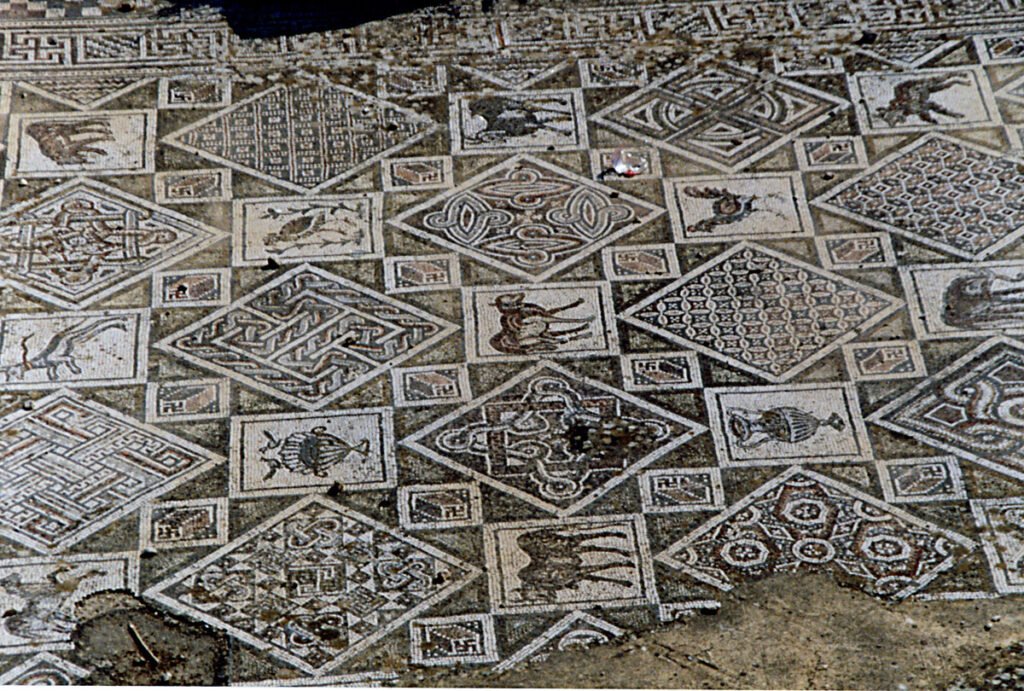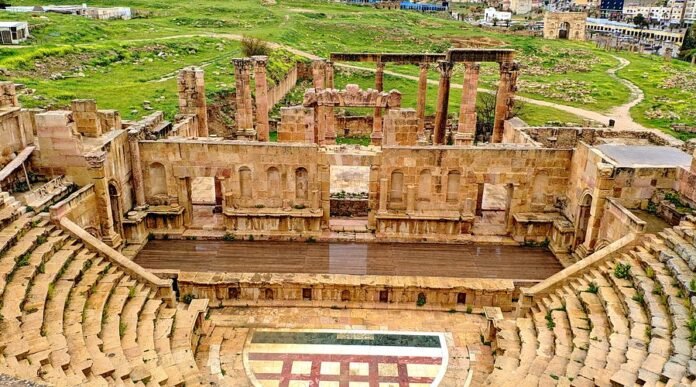Jerash, ancient Gerasa, stands as one of the world’s most complete Greco‑Roman cities outside Italy, a real-life time capsule spread across the hills of northern Jordan. This blog will take you on a journey through its grand colonnades, majestic theaters, sacred temples, intricate mosaics, and early Christian churches—revealing the vibrant, layered life that once pulsed through these streets.
🏛️ 1. A Roman Marvel: The Colonnaded Streets & Ceremonial Gates
At the heart of Gerasa lay the Cardo Maximus, an 800‑meter-long north‑south colonnaded avenue where merchants, citizens, and dignitaries would mingle under towering Corinthian columns . Crossing it was the impressive Hadrian’s Arch, commissioned in AD 129‑130 to honor the emperor’s visit—a triple‑arched gateway vaulted in Corinthian style, once soaring nearly 22 m tall
These colonnades formed the city’s skeletal spine, lined with shops, fountains, and vibrant street life—truly the social and economic hub of urban Roman life.

🎭 2. Dramatic Performances: The Theaters of Gerasa
Gerasa was home to three ancient theaters, of which the South Theater is the most dramatic—a semi‑circular stone amphitheater hewn into the hillside, seating some 4,700 people . Inaugurated around 90 AD under Domitian, its outstanding acoustics still resonate during the Jerash Festival today .
Imagine ancient Romans or early Christians gathering here, not just for entertainment but for civic gatherings—each performer delivering to the rapt face of history.

🛁 3. Public Life & Hygiene: The Grand Roman Baths
Step off the colonnades and descend to the Great Eastern Baths, a monumental complex of barrel‑vaulted halls nearly 11 m high and covering some 9,000 m². These baths were more than places to bathe—they were hubs for socializing, politics, philosophy, and relaxation. Marble sculptures once adorned its halls; fragments of statues remain today, found in recent excavations.
Picture this: it’s the 2nd century AD, and citizens pass through changing rooms to fragrant steam rooms, warm baths, then return to heated lounges to sip wine and debate.

⛪ 4. Spiritual Shifts: From Pagan Temples to Byzantine Churches
Temple of Artemis
The sprawling Temple of Artemis, once dedicated to the city’s patron goddess, was built in the mid-2nd century AD. Featuring eleven standing Corinthian columns, it was richly adorned with polychrome marble. By the 4th century, pagan worship fell to imperial decree—its marble cladding stripped, cella paved over with mossy stones, and eventually converted into a public hall
Rise of Byzantine Christianity
From the 5th to 6th century, Gerasa blossomed as a Christian city. On the west bank alone archaeologists have identified 13 churches—including the monumental Cathedral of St. Mary (450‑455 AD), Church of St. Theodore (494‑496 AD), and Church of Cosmas & Damian (533 AD).
Beneath one Byzantine church lay a repurposed synagogue, evidenced by Hebrew-Aramaic inscriptions in a mosaic floor—a symbol of evolving religious landscapes

🎨 5. Byzantine Mosaics: Floors That Tell Stories
These early churches are famous for their vivid mosaic floors, richly decorated with geometric patterns, Christian symbols, and even donor inscriptions. Particularly noteworthy are:
Early 3rd‑century floors depicting historians like Thucydides, found in Roman houses and baths nationalgeographic.com.
A mosaic beneath the Church of Saints Cosmas & Damian.
The mosaic carpet in the Church of Bishop Marianos (AD 570), featuring name inscriptions and ornate religious motifs jordangrouptours.com.
Walking across these mosaic marvels, you can almost sense the footsteps of ancient worshippers, reading the motifs placed beneath them centuries ago.

🪨 6. Byzantine Inscriptions & Early Church Architecture
Beyond their mosaics, the churches of Gerasa offer a rich tapestry of inscriptions and architecture:
- Bishop Theodore’s Church includes poetic inscriptions hailing the saint and celebrating Christian dominance over “pagan disorder” .
- Church of Bishop Genesius (AD 611) features dedicatory mosaics naming its founder.
Structurally, the basilican layout—long halls, side aisles, and apses—mirrors early Christian architectural innovations throughout the empire.
🌀 7. Layers of Time: From Earthquake to Rediscovery
Gerasa’s story is one of transformation and resurrection. A massive earthquake in 749 AD buried much of the city, and it lay forgotten until rediscovered by European travelers:
- In 1806, Ulrich Jasper Seetzen sparked interest among antiquarians.
- Ongoing excavations from the 1920s onward, often aided by numbered stone blocks, have gradually pieced together the city’s complex past .
Today, that careful restoration allows us to walk the same stones, breathe ancient air, and glimpse those grand civic dreams.
🎥 Jerash Today: What to See & When
Modern visitors to Jerash can marvel at:
- Hadrian’s Arch – walk beneath 11‑m Corinthian vaults.
- Cardo Maximus – stroll beneath colonnades once lined with shops.
- Great Eastern Baths – feel the vaulted grandeur of ancient social centers.
- South Theater – watch or participate in live performances at the Jerash Festival.
- Temple of Artemis – see early Christian reuse of pagan temples.
- Cathedral & Nine Other Ruins – all boasting richly decorated mosaics, inscriptions, and basilica structures.
Visit Tips: Best explored in spring or fall—summer can be scorching. Wear sun protection and water, and allow half a day to walk the expansive site.
For More Ancient Blog Read This click here
